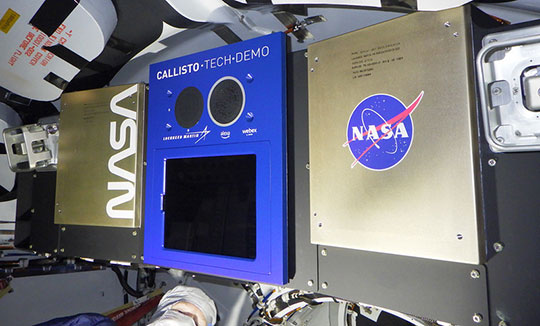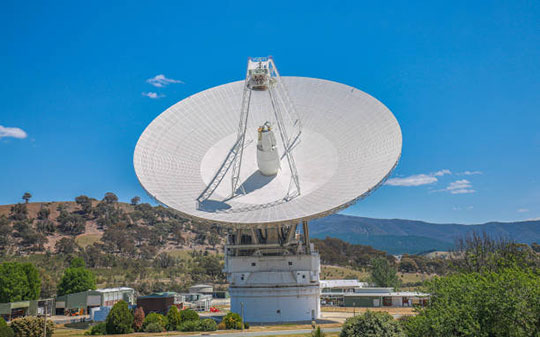 Callisto technology payload installed on Orion. (NASA Orion Spacecraft/Flickr)
Callisto technology payload installed on Orion. (NASA Orion Spacecraft/Flickr)
In Podcast Episode 133, Constellations spoke with Webex’s Jono Luk about deep space video collaboration. In this article, Mr. Luk, takes a deeper look at how it works.
Despite what you’ve seen in your favorite sci-fi movies, real-time video communication from space isn’t as simple as it looks. In reality, engineers must tackle a multitude of unique challenges to deliver the seamless communication required for space travel and deep space exploration. Much different from the solutions that enable us to communicate and virtually meet with others on Earth, space tech is more challenging as there are extreme distances, random but potentially deadly cosmic radiation and space noise to consider. For instance, the video signal to talk with someone who is on the Moon - 240,000 miles away in real-time - must travel more than 10 times the Earth’s circumference! Getting real-time communications to work in deep space as it does here on Earth is going to take much innovation to say the least.
Understanding the need for modern and immersive communication capabilities, Webex has been working with Lockheed Martin and Amazon Alexa to provide a high-quality video experience while navigating these potential issues. Webex is an integrated part of Callisto, a technology demonstration onboard NASA’s Orion spacecraft that is part of the Artemis I uncrewed mission around the Moon and back to Earth. Callisto will use Webex to test and demonstrate the use of commercial technology for deep space voice, video, and whiteboarding communications that will enable astronauts to be more self-reliant as they explore deep space.

Cable is out, antennas are in
The fastest connectivity speeds known today are 70% the speed of light and powered by fiber optic cables. Since tethering spacecraft with fiber optic cables isn’t feasible in space, engineers utilize the largest, most sensitive scientific telecommunications system in the world: NASA’s Deep Space Network (DSN).
NASA’s DSN array is comprised of three facilities that house enormous radio antennas located in California, Spain and Australia. These antennas are designed to enable continuous and reliable radio communication between Earth and space. Even as the planet rotates, the skillful placement of each facility ensures continuous connectivity between NASA stations and spacecraft as they move further from Earth. NASA’s Deep Space Network is our Internet for Callisto – it is how signals will transit from Mission Control in Houston, where Virtual Testing will happen - to Orion as it reaches the far side of the Moon. NASA is already investigating next generation technologies to increase the bandwidth available for mission activities. Just as we have progressed the speed of our Earth-bound internet from Kilobits-per-second (Kbps) to Gigabits-per-second (Gbps), NASA has also been evolving the technology of the DSN – starting with S-Band and then X- and Ka-band to increase the bandwidth available for the plethora of activities that humankind wants to perform in space.

Bandwidth at the tip of the iceberg
Extremely limited bandwidth is one of the many constraints for seamless deep space communications. HD-quality broadcast is essential for meaningful communication, but it consumes significant bandwidth, so engineers had to find an efficient solution to overcome this lack of bandwidth and bring forth a new era of connected space exploration. To achieve this, engineers further enhanced the Webex technology in Callisto, compressing video with industry-leading technology to ensure video could be transmitted at the highest video resolution possible for the mission with the limited bandwidth available to Webex – about 128kbps. For reference, a typical video conference in 2022 uses ten times more bandwidth to transmit high quality video.
Similarly, latency also creates another barrier for effective deep space video communications, since the data (audio and video feed) can only travel so fast. When spacecraft are in Low-Earth Orbit (LEO), the delay in video and sound transmission is negligible due to the short (in galactic terms) distance the signal needs to travel - causing some delay between when information is sent from the spacecraft and when it’s received at Mission Control. This minimal delay is perhaps a nuisance during an interaction, but not inhibiting. However, as we continue to explore further and further out into the cosmos – starting with around the Moon and soon to Mars and beyond – innovative solutions are needed to mitigate those aspects of latency.
While we cannot make signals go faster than light, we can at least try and compensate for the realities of the delay in signal reception and the impact on those that are engaged in the video interaction. To mitigate these audio and video delays in deep space collaboration, custom buffering technologies that organize and efficiently transfer data from the source to the destination are imperative. Callisto will be the first test to show how Webex can handle extreme latencies, ensure transmissions are intact and preserve the continuity of interactions no matter the delay. These technologies are pushing the boundaries of deep space video collaboration, and that’s only the beginning!
The Art of the Possible in Deep Space Communications
The power of video communication is immense and will ultimately be a driving force behind greater space exploration and human connection. Through video collaboration, the possibilities of seamless communication from space to Earth are endless. In fact, I would like to leave you with some final thoughts about the Art of the Possible with Webex.
I see the Art of the Possible as being about dreaming BIG and turning pipedreams into a reality.
It’s about asking questions like how can we all make tomorrow’s world a better place and even go as far as the stars? By bringing the best technology, tenacity, and human collaboration together - I believe we can turn pipedreams into a reality. Video communication is the beginning of what could be possible for space travel and deep space exploration. As we embark upon this journey, I am even more excited about what’s to come in the future.
